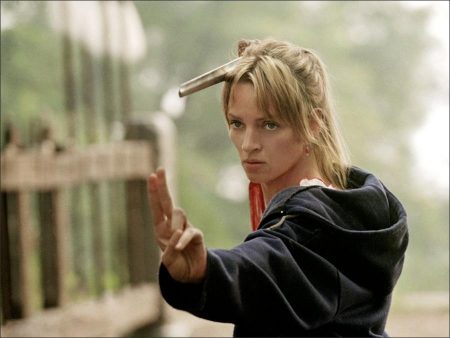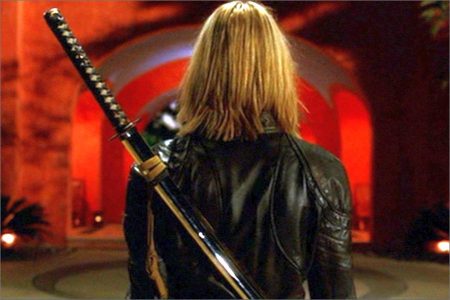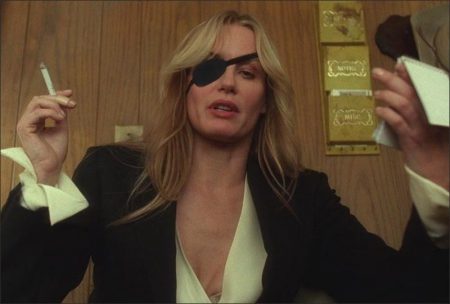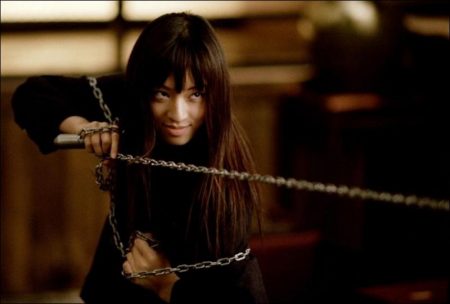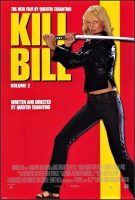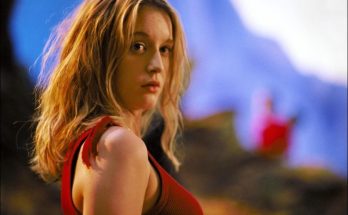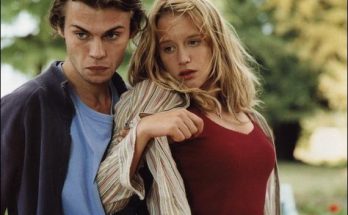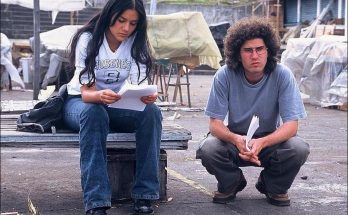In Kill Bill Vol. 1 we learned that Bill, a broker of killers for hire, had assembled and trained a ruthless assortment of assassins, the so-called Deadly Viper Assassination Squad (DiVAS). Each of these gifted murderers was code-named for a different species of poisonous snake: O’Ren-Ishii (Lucy Liu) was Cottonmouth, Elle Driver (Daryl Hannah) was California Mountain Snake, Vernita Green (Vivica A. Fox) was Copperhead, and Budd (Michael Madsen), Bill’s kid brother and the only other male in the Viper Squad, was known as Sidewinder.
The lethal weapon known as Black Mamba, played by Thurman, the most talented of them all, was also Bill’s lover, and she became a fugitive from the assassination game when she learned that she was pregnant with his child. At that moment her worldview shifted on its axis. She no longer wanted to kill or to put her life in mortal danger. She changed her name, hid out in a small town, and found herself a kind and stable man to a marry.
But Bill was not about to let this situation stand. We caught a few glimpses of the result early in Kill Bill Vol. 1 with the wreckage left behind when Bill and the Vipers assaulted a tiny rural chapel and slaughtered everyone in sight. Vol. 2 gives us, for the first time, a full account of the wedding rehearsal massacre that sets the plot of this two-part epic in motion. After fending off attacks from Bill’s trailer-trash kid brother Budd (Michael Madsen) and her chief rival within the Squad, Daryl Hannah’s Elle Driver, The Bride tracks her ultimate quarry to his lair in Mexico.
The film’s central relationships between hunter and prey, which Carradine describes simply as a love story, has one of its strongest expressions in Bill’s deceptively serene introduction scene in Vol. 2 : “I show up in Texas during her wedding rehearsal, outside on the porch, and I’m playing my flute. It’s the sound that first tells you I’m about to appear. She hears this and comes out, and we have this very romantic reunion, which is also a goodbye. I mean, this scene just sings. The crew got choked up watching it. Quentin came over to me and said; ‘I think this is the best scene in the picture for you.’ And I said, ‘I think it’s the best scene of my career.’”
For a filmmaker as genre savvy as Tarantino, the touchstone for Bill’s both Satanic and paternal character, and his intense relationships with The Bride and her sister Vipers, is not far to seek: “Bill is a pimp,” Tarantino declares. “He’s a procurer in every way, except for him it’s about death, murder, and killing as opposed to sex: seeing a girl who he thinks has a prostitute hidden inside her, but she doesn’t know it yet. All he has to do is bring it out, to turn her and make her part of his stable.”
The relationships within the squad fit into the same psychological pattern, and one of the most fraught is the one that has been simmering for years between The Bride and Daryl Hannah’s dramatically eye-patched Elle Driver (a.k.a. Sidewinder). Elle played a small but key role in Vol. 1 – attempting to deliver a chemical coup de grace to the comatose and hospitalized Bride – but in Vol. 2 , the rivalry comes to a head in an all-out “cat fight”.
“In the hierarchy of the Deadly Vipers,” Tarantino explains, “Uma’s the top one. She’s the one who has Bill’s ear and heart. If Bill is the pimp, Uma’s character is the number one lady in his stable, the girl who keeps the other whores in line, and Daryl Hannah is Uma’s opposite number. They’re both these amazons with long legs, long arms, and long whipping blonde hair. They’ve been at odds from the beginning, and when Uma went out, Daryl went in. She was The Bride’s replacement in every sense.”
In fact, Hannah worked on the assumption in her performance that Elle Driver was a former Interpol agent who at some point caught up with Bill and tried to arrest him, only to be seduced and “turned.” “The Bride used to be Bill’s girl and now Elle Driver is Bill’s girl,” Hannah says. “So Elle really wants to see The Bride go. She wants to be the one to finish her off.”
Hannah was performing on stage in London in director Michael Radford’s production of The Seven Year Itch , when Tarantino surprised her with a backstage visit, offering the role he’d written specifically for her. Hannah jumped at the chance to work with Tarantino, adding: “I’d never played a full-out villain before, so I was really excited when I realized what a bad ass Elle Driver was.”
One of Quentin Tarantino’s favorite actors, Michael Madsen, was asked to play Budd, a washed-up veteran of the Viper Squad who comes out a retirement and gets a new lease on life (at least briefly) in Bill’s fight against The Bride. Madsen had not worked with Tarantino since 1992, when he created one of the most memorable characters in the director’s debut movie Reservoir Dogs , the sardonic, ear-slicing Mr. Blonde. “He hasn’t changed at all,” Madsen happily reports of his reunion with the director. “He’s totally and absolutely the same guy he was before. But now he has bigger toys to play with.”
Budd is Bill’s wastrel younger brother, Madsen says, “and there’s nice progression of Budd as a character. There’s the younger Budd in the early Viper days, then there’s the older Budd that has gotten lost, who works as a bouncer in a strip club and lives in a trailer. We called him ‘Budd in a Bottle.’ He’s a character that I think is equally as memorable as Mr. Blonde.”
“My character’s relationship with his brother, with Bill, is very complex. I’ve got four sons myself, and David obviously grew up with several brothers, so I think we understood the dynamics of brothers. David has certain, uh, nuances of character, and I’m a bit of a quirky character myself. We had a sort of bantering relationship going on the set. So when they stick us together I think it’s easy to buy that we’re brothers.”
Kill Bill is still a movie strongly influenced by Asian martial arts films, and in that universe no relationship is more crucial than the one between student and teacher, master and disciple. In fact, Kill Bill has two masters. Each of the two volumes has its own tone and narrative strategies, and in terms of its Asian influences Vol.1 was clearly dominated by Japan and the code of bushido , as personified by Sonny Chiba ( The Streetfighter ), who played the samurai sword maker Hattori Hanzo and served as the film’s kenjutsu choreographer.
Vol. 2 , on the other hand, is strongly influenced by the martial culture of China, as personified by martial arts movie legend Gordon Liu Jia-hui ( The Master Killer ). “My two favorite things in the course of making this movie,” he says, “as far as goose bump moments, was doing scenes with Sonny Chiba and Gordon Liu.”
Tarantino cast Liu initially only as Johnny Mo, a leather-clad leader of Lucy Liu’s Crazy 88’s bodyguard squadron in Tokyo in Vol. 1 . Until well into pre-production he was intending to play the Bride’s draconian martial arts instructor himself, a variation on a popular bad guy from several vintage Hong Kong martial arts films of the 1970s, the “white eyebrow monk” Pei Mei. Tarantino joined the rest of his cast on the training floor in the early days of the lengthy martial arts training camp sessions that were held during pre-production, working hard to get ready to play Pei Mei. “I had been watching these movies for years,” he says, “and admiring the performers and thinking how cool they were. There was no way I was going to let the girls have all the fun!”
But when he began to understand how demanding the pre-production chores on this complex film would be, Tarantino realized that he simply didn’t have time to act on top of all that, much less to train arduously for eight hours a day. He turned to Gordon Liu as the obvious choice to assume the role, a performer who had, in effect, been in training all his life to portray a steely martial arts master.
In a sense, Tarantino was casting against type when he asked Gordon Liu to play Pei Mei. Liu had always portrayed stalwart, or occasionally comic, heroes in his classic Shaw Brothers films. He became an international martial arts star, second in fan status only to Bruce Lee, as the redoubtable shaven-head martial monk San Te in Liu Jia-liang’s The 36 th Chamber of Shaolin (1978), known as Master Killer in it’s English-dubbed incarnation.
Pei Mei, on the other hand, while also a monk, was one of the Shaw studio’s darkest villains, betraying his martial brothers of the Shaolin Temple to the Manchu tyrants in pictures like Liu Jia-liang’s Executioners From Shaolin (1977). Pei Mei was such a popular baddie, in fact, that several semi-sequels and prequels were quickly created, even though the evil one had died decisively in his very first screen outing. “But,” says Liu, “I understand why Quentin wanted me, even though I’ve always played righteous heroes. He was looking at me for my martial arts skills, and also I think because of my understanding of this very Chinese character.”
Liu admits that one thing he did not know much about when he was first approached to appear in Kill Bill was Quentin Tarantino or his films: “But I asked some friends in the entertainment business, and they recommended Reservoir Dogs and Pulp Fiction , and I watched them and I was impressed. His work is unique and very interesting; something you have never seen before. And I heard that Quentin knew a lot of Hong Kong movies and martial arts movies.”
Tarantino continued to cast a wide net in Kill Bill Vol. 2 using performers whose work he had been enjoying for years. He described Michael Parks, for example, as one of his favorite American movie actors. Parks won the young Tarantino’s allegiance when he starred in the classic ‘70s television series Then Came Bronson , and was later cast by writer-producer Tarantino in From Dusk Till Dawn (1996), directed by Robert Rodriguez. Here, Tarantino has cast Parks in two more roles, one in each of the two volumes of Kill Bill . Parks is small town Texas Sheriff Edgar McGraw in Vol. 1 , investigating the grisly wedding rehearsal crime scene. In Vol. 2 he is the elderly Esteban Vieho, a brothel owner and Bill’s mentor who helps The Bride locate her arch-nemesis in Mexico.
Relationships matter in Kill Bill Vol. 2, both behind and in front of the camera. But it is worth pointing out that the new film still displays some signs of what Tarantino described as a “duck press” approach to absorbing the influence of his favorite “grindhouse” genre films.
“When I come to do a scene that’s like something you might see in an Italian gialo [slasher movie] or in a kung fu film,” he says, “I know how they would have done it over there, so I’m going to shoot it that way . This is why my films play so well all over the world. I don’t really think of myself as solely an American director. People in just about any country can see things in my films that they can understand and enjoy.”
This overall approach to the film was a key determining factor when it came to picking the crew for this unusual project. Academy Award winning Director of Photographer Robert Richardson was chosen for Kill Bill precisely because he had proven himself adept at achieving a wide variety of looks. He has been a frequent collaborator with Oliver Stone, on films such as Natural Born Killers and JFK , which cut back and forth between different looks and even film stocks within a single sequence. The concept of Kill Bill involved shifting the pictorial and cutting style of each episode, in keeping with its mix ‘n’ match genre roots, therefore Richardson was an obvious choice.
In Vol. 2, the impact of two particular genres is especially evident. “If my life had two sides,” Tarantino says, “one side would be the period martial arts pictures made by Shaw Brothers in the 1970s, and the other side would be Italian Westerns. Actually they both have influences on each other. During the 1970’s, movies from these two genres often used the same plots, similar images and shots, even some of the same music. There are many things in Shaw Brothers movies which were borrowed from Italian Westerns. There’s a fairly deep kinship.”
The on-screen relationship between the film’s two formative genre styles is straightforward: The present time sequences, set in the American Southwest and Mexico, adhere to the style of the Italian Westerns. The flashback sections, set mostly in China, where Bill takes The Bride for a period of training with his own former master, Pei Mei, have the “training-for-revenge” structure of a classic kung fu picture.
As befits the stress of the second Kill Bill film on western American and Mexican locations, the movie’s soundtrack features a raucous number by the Southern rockabilly great Charlie Feathers, “Can’t Hardly Stand It,” along with classic cuts from Ennio Morricone’s score for Sergio Leone’s classic Spaghetti Western The Good, the Bad, and the Ugly (1966), and “Urami Bushi” (“Love Song of a Warrior”), originally performed by leading lady Meiko Kaji in the Japanese samurai picture Lady Snowblood 2: Love Song of Vengeance (1974).
Tarantino’s fans know that he is almost as passionate about music as he is about movies. Tarantino has said that when he was a young film fan, before the advent of video, movie soundtrack albums were the only way available to re-capture the experience of a film. He says that re-imagining scenes from his favorite films, and sometimes improvising in his head as he listened to the music, was his first experience of thinking like a director. And now his choices about music enter into the creative process right from the beginning. “I can’t really go forward with the writing,” he says, “until I find out what the opening music is going to be, the music that will put people in the mood. It’s the music that helps me find the rhythm of the movie, the beat the movie will play to.”
This process continues on the set, as Tarantino plays music to put people in the mood for a scene, or in this case to set the beat for a fight. As Gordon Liu told Ain’t It Cool News.com, “Quentin already has a music tempo in his head for each fight sequence.”
For work on the score, Tarantino again turned to The RZA (pronounced “Riza”), the groundbreaking producer of several albums for the hip-hop group Wu-Tang Clan, an outfit that drew much of its inspiration (and many sound bites) from Chinese martial arts films. The RZA had also produced solo albums, including two under the name Bobby Digital. He created the score for the Jim Jarmusch film Ghost Dog: The Way of the Samurai (1999) and for Kill Bill Vol. 1 (2003).
Tarantino’s friend and occasional collaborator, writer-director Robert Rodriguez, with whom he collaborated on the south of the Border vampire tale From Dusk Till Dawn (1996), was recruited to compose some appropriate music for the Mexican sequences in Kill Bill Vol. 2 . Rodriguez composed a full score for his 2003 action film Once Upon a Time in Mexico , with Antonio Bandaras, and for all three films in his hugely popular Spy Kids trilogy (2001-2003).
Made in China
For Kill Bill producer Lawrence Bender, “Going to China was the best thing that we did. Quentin felt very strongly that when he was in China, he wanted that input, to have a Chinese creative team. He didn’t want an all-American crew to go over to China and say, ‘This is how we’re going to do it.’ And as a result our Japanese and Chinese art teams did stuff together that no one could have ever dreamed of.”
Bender, Tarantino, and the principle cast traveled to China in May, 2002, to continue training and action choreography, and to begin rehearsals. By mid-June line producer E. Bennett Walsh, associate producer Dede Nickerson, production supervisor Koko Maeda, and Academy Award-winning director of photography Robert Richardson had put together a multinational crew, with several teams of translators, and had settled into work at the Beijing Film Studios, located in the northern section of the Chinese capitol.
Kill Bill employed a Chinese, a Japanese and an American production designer, a Chinese and an American costume designer, and a Chinese and an American prop master. A team of Chinese and American assistant directors supervised the day-to-day operation of the production. American first assistant director Bill Clark, a veteran of Tarantino’s films since Pulp Fiction , worked closely with Chinese first assistant director, Zhang Jin Zhan to coordinate the massive cast and crew.
“It’s two very different ways of working,” Bender explains. “The American way is very precise. You’ve generally got one or two guys on each piece of equipment, and they are quiet and orderly. But the Chinese way is to have twenty people making a ton of noise and all working to get it done. They use a lot more crew and they get things done very quickly.”
On their first day in China, the Kill Bill crew completed twenty-two set ups, almost unheard of for a typical Hollywood production. After completing their work at the Beijing Studios, where the huge set for Vol. 1 ‘s House of Blue Leaves was constructed, the cast and crew set out for a week of location shooting at an ancient temple in the town of Zhongwei.
First built in the 17 th century the Gao Temple “is a magnificent jumble of buildings and styles covering an area of about four thousand square meters,” according to a Chinese tourist web sit. The arduous daily climb to the set, up a massive flight of stairs on the east side of Miao Gao Mountain, 240 meters high, was only a taste of the rigors involved in filming the Shaolin kung fu training sequences featuring Uma Thurman, Daryl Hannah, and Gordon Liu, “The Cruel Tutelage of Pei Mei.”
The action sequences in the Kill Bill script were already unusually detailed. Tarantino had been re-writing and refining them in the planning, training, and rehearsals phases for the better part of a year. In Beijing he continued the process, describing the scenes in even more detail and when necessary acting them out. Surrounded by a team of Japanese, Mandarin and Cantonese translators, he worked through each shot as the crew, the actors, Master Yuen, and the wirework team watched and walked through it alongside him. By the time they hit the ground on Miao Gao Mountain, they were ready to rumble.
Master Yuen Woo-ping, who brought his martial arts skills and unique “wire fu” expertise to the task, learned his craft from his famous father, the late Beijing opera veteran and film actor Simon Yuen Hsiao-tien. Working as director later in life, Woo-ping cast his father in the title role in the Jackie Chan vehicle Drunken Master (1978). Master Yuen makes a point of saying that the techniques he teaches are theatrical rather than combat oriented. “It’s Northern-style stage acrobatics or stage martial arts,” he says. “Totally different from combat kung fu, or even from wushu , the acrobatic Olympic-style sport they invented in China, which is what Jet Li studied. When you learn Beijing opera it seems almost the same as martial arts, but when you use it it’s completely different, because of the camera or the stage. It’s always primarily for display.”
Daryl Hannah put it well: “I’m pretty well-trained now at martial arts. But I’ve been trained to miss. So I could hit you, but I would hit you really hard about that far in front of your face. I have no idea what would happen if I actually made contact!”
Master Yuen’s action choreography has been featured to great acclaim in The Matrix and its sequels, and in Crouching Tiger, Hidden Dragon , as well as in dozens of Hong Kong productions But Tarantino was a Yuen fan long before the Master achieved his Western breakthrough. In fact, Tarantino was instrumental in arranging the domestic release of Yuen’s directorial masterpiece Iron Monkey (1993), which was distributed by Miramax Films under the “Quentin Tarantino Presents” banner in 2000.
“I think the first film that I saw of Master Yuen’s was a film with Jackie Chan called Snake in the Eagle’s Shadow ,” Tarantino recalls. “It was around 1993 or 1994 that I started noticing his distinctive kung fu style, his choreography. I think he’s most imaginative kung fu choreographer of all time. He has impeccable craftsmanship and also a wild imagination. He is my most admired director and action choreographer. In this movie, I did the basic design of the actions. Yuen Woo-ping said I didn’t have to know too much about kung fu, understanding what kung-fu movies really were was enough. He would do the rest. After he joined in, I have felt more confident and I can make any of my thoughts come true.”
Hong Kong cinema legend Gordon Liu came to his work with Master Yuen Woo-ping on a very different footing from some of the other performers. A student of Chinese martial arts from the age of seven, and a major Asian film and television star, Liu is a Master in his own right. So how do two masters interact on the same movie set? According to Liu, very cordially, indeed.
“Master Yuen knows where I come from,” he says. “Although our backgrounds are in different styles he sees me as a master and treats me as a master. Master Yuen learned a Northern China style of martial arts, and I learned a Southern style, but there was no tension on the set because we have both done many movies, with many different kinds of performers and choreographers. I worked very happily with Master Yuen Woo-ping.”
There is an even greater divergence in the kind of martial arts work the two men have done in movies. Most of Liu’s work as a performer in Hong Kong was in films directed by his elder “god-brother,” Liu Jia-liang, who placed a premium on authentic depictions of regional martial arts styles. Master Yuen Woo-ping, on the other hand, is most famous for a graceful, high-flying style of fantasy swordplay.
“Master Yuen’s work in Crouching Tiger, Hidden Dragon ,” Liu says, “was very beautiful, a work of art. But it was not real fighting. I knew that Quentin wanted something different. He wanted real fighting. And I knew that when those two approaches were put together, the result would be something unique.”
He was also familiar with was the challenge of being the only actor in a fight sequence who has studied martial arts. “Most actors who do these films,” he says, “even in Hong Kong, just learn the specific moves for the scene, as Uma did in Kill Bill . This is like learning lines in a foreign language phonetically. Very difficult to make it look as if you understand the meaning. Quentin and Master Yuen expected me to do well, because of my background, but they also wanted Uma to be good, because she was the main actress. So I was the key person to make the fights look good.
“If I fight with one of my brothers or another martial artist,” he explains, “they know what to expect, where to turn and stop. With a non-martial artist I have to make an extra effort or add an extra movement to make sure the routine ends up in the right place. I always have to cooperate and make the other person look their best. Also when both people know martial arts and your arms touch each other, they don’t feel a thing. It’s very natural. With a non-martial artist I’m always worried that if I hit them the wrong way, they will get hurt.”
As a lifelong master of North Shaolin-style Hong Fist kung fu, Liu has a special appreciation of the challenges Thurman had to overcome: “The Chinese martial arts are especially difficult for someone who is a beginner, and for someone who is tall, because their center of gravity is too high. You will notice that most of the great martial artists are smaller in size: Bruce Lee, Jackie Chan, Jet Li. If you are smaller, it is easier. Uma knew that this was not her expertise but she never gave up. She kept trying. I was very impressed by her spirit. Some people in her place would have let a bad take go by, they would have said it’s good enough, but she didn’t. She would re-do it again and again until it was up to her standard.”
Gordon Liu was impressed when he learned that David Carradine has been cast in the movie’s title role. He made a point of taking Carradine aside, when they were on location together in at the Temple, to tell him how much he had admired the internationally popular television program Kung Fu . “That series was a very important part of people in the West understanding kung fu,” Liu explains. “I have great respect for Quentin, too, for helping spread kung fu and martial arts to audiences outside China and the Far East.”
Yuen Woo-ping, generally regarded as the world’s greatest living master of movie martial arts, was unequivocal in his praise for Thurman’s accomplishments. As Tarantino recalls, “He came to me one day and said, ‘Quentin, you don’t know how truly good Uma has become.’ He said with some actors who look good in movies it’s like, one or two moves, very well executed, and then you have to cut. Uma was doing four and five move routines, picking them up on the spot. She does this move where she goes up in the air, does a somersault on the wires, lands, and kills two people. That’s a big deal. She got so good and so confident at that Woo-ping and I could change the choreography any time we wanted.”
“At the end of my training in Los Angeles,” Thurman agrees, “I was starting to feel more capable. And during the last week or so I just basically drilled choreography every single day, learning hundreds of moves and combinations that were part of that fight. And then when we went onto the set to start shooting the fight they introduced this new idea, that all that choreography could just go right out the window. We would change it on the spot and I would have to learn immediately five, ten, fifteen point fights on the spot, while the camera was waiting. And what I suddenly sort of realized was that the most important thing they taught me was how to learn.”
One of the hard lessons the actors still had to learn is that no amount of training, even with true masters, can fully prepare any fighter for the reality. For Master Yuen Woo-ping, “It all depends what the camera demands. I have always used techniques like hiding the fist with camera placement. But sometimes when the point is how much force is behind the blow, we have to do it more realistically, with real contact. A lot depends on whether the actor who is being hit can ‘sell’ the blow, whether his or her reactions makes it look harder than it really is.”
For Tarantino, filming in China offered a unique opportunity to commune with the spirit of one of his own moviemaking master. “The two film companies I have had the most affection for as a fan,” he says, “are probably Roger Corman’s New World Pictures in the 1970s, and Sir Run Run Shaw’s Shaw Brothers. And the king of the Shaw Brothers directors, for my money, was Chang Cheh. He holds the place in Old School kung fu movies that John Ford holds in Westerns. He made a movie in 1967, One-Armed Swordsman , with Jimmy Wang Yu, that was really the first that we would recognize today as a martial arts film. He was a true pioneer. He died in 2002, but when I was shooting Kill Bill, I sometimes had the feeling that Chang Cheh was watching over us.”
One particular production problem, Tarantino says, was solved directly by Chang; by adopting a technique he had invented. The current special effects devices for simulating blood flow are fairly complicated, “with tubes and wires. I wanted to forget that we were making this big budget movie and do it as if we were 13-year-olds shooting in the back yard. And then Yuen woo-ping says, ‘You know how we did blood gags in kung fu movies in the 1970s? We’d take a Chinese condom, fill it with blood, and the actor who was to die would hold it in one hand. When the other guy sliced him he’d squeeze the condom and the blood would fly. And it looked great. And it was Chang Cheh who invented that.’ So we tried it, and the effect was excellent. I wouldn’t have been able to get half of the effects I wanted if we didn’t have that gag.”
Back in the USA
In the Pei Mei flashback sequences, Tarantino honors a central convention of kung fu cinema: the “training for revenge” motif, in which we see a student acquiring skills that will pay off decisively in a later battle. Here the master passes on two top secret lethal techniques that The Bride has occasion to use only years later, when her quest for revenge takes her back to the US for a re-union with her daughter, to climactic encounters with her bitter rival, Elle Driver, and to a final showdown with Bill himself.
The preliminary bout to these title card events is the surprisingly heartfelt and vicious encounter between Elle Driver and Sidewinder Budd, Bill’s kid brother. Asked to account for the intensity of their battle, Hannah says: “Michael Madsen plays Budd, and Michael is a lovely guy, but Budd is sort of a despicable alcoholic. At least that’s my character’s opinion of him. He used to be a professional but now he just sits around in filth and drinks all day and does nothing. So we have to own up to our distaste for each other”
The scene includes a dramatic appearance by The Bride’s namesake, an actual Black Mamba, the deadliest poisonous snake on earth. “I bring a little friend to visit Budd,” Hannah agrees. “We had an actual Black Mamba on the set, which I guess they took the venom sacks out of.”
“It’s a creepy snake,” admits Madsen, whose character was on the receiving end. “If you get that venom in your system, it’s over. It’s a slow suffocation. Reading that scene was one thing, but the actual scenes with the snake were a little harder to get through than I thought they would be. Although I also think that helped the energy of the scene.”
Tarantino had something special planned for the showdown between archrivals Elle Driver and The Bride: “I wanted it to be the ultimate cinematic cat fight of all time. It’s not a martial arts fight, alright, it’s a catfight. I mean, it sounds exciting: Uma Thurman and Daryl Hannah having a fight to the death. I’d pay to see that. Daryl, you know, actually starred in a TV version of Attack of the 50 Foot Woman , and there was even something about the very idea of this fight that made it sound like a Japanese superhero movie. I almost wished there was a way I could feed them a pill that would make them both 60 feet tall so that they could have their fight in a city and destroy half of it. In terms of re-creating my favorite Asian film genres, that’s really the only stone left unturned.”
Tarantino was able to give a nod to Japanese giant monster films: he used the actual scale model of Tokyo that was constructed at Toho studios for their Godzilla films as the backdrop for a shot in Kill Bill Vol. 1 of The Bride’s plane swooping down over the city.
Finally, it all comes down to Bill: David Carradine. As an undisputed global icon of the Kung Fu Craze of the 1970s, and a boyhood idol of Quentin Tarantino, Carradine clearly deserves a prime niche in a film designed, in large part, as the writer-director’s loving tribute to one of his favorite genres. Shaw Brothers great Gordon Liu has acknowledged the importance of Carradine’s performance as Caine on the ABC-TV series Kung Fu in popularizing the Chinese fistic arts around the world.
The actor admits, however, that he didn’t know what to expect when he was first asked to consider playing this thoroughly evil title character. “Quentin’s pictures feel like they’re improvised,” he says, “So I wondered, ‘When I open the script, what am I going to see?’ But it’s literature, and it worked out to the last possible detail. Nothing is left to chance.
“Quentin has got to be my favorite director, certainly my favorite living director. He’s very delicate in the way that he deals with actors. Hal Ashby I dearly loved, but Quentin is more my kind of person, my kind of guy, and we have a lot to talk about.”
A lifelong student of the martial arts, Carradine has often spoken modestly about his accomplishments in that area. “[When I was doing the TV show] I made no secret of my ignorance of kung fu,” Carradine wrote, in his 1991 memoir The Spirit of Shaolin: A Kung Fu Philosophy . “When asked I’d say, ‘I know nothing.’ And then make some subtly dazzling move. I was being funny, sure. What I also meant was that what you see, what I do, although graceful, fast and effective, is nothing compared to what there is to be learned.” Even so, Carradine admits, when it came to the martial arts training required for his role in Kill Bill , “I thought I had a leg up on all the other cast members. I thought, ‘Well, hey, I don’t need this training. I’ve been doing this stuff for forty years.’ Well, no. It was tough. I had to re-learn everything I thought I knew.”
The finale of Kill Bill involves a fair amount of violence, but it revolves around the tension filled meeting of two estranged parents in the presence of their child.
“One of my favorite scenes,” Carradine says, “not just in Vol. 2 but in the entire movie, is a long, long dialog scene between Bill and The Bride. Really it’s the main part of the love story. And all the time we know that these two people will have to fight to the death. So this movie is not just the violence, it’s not the action. It’s an inside look at the minds and hearts of violent people.”
Kill Bill Vol. 2 (2004)
Directed by: Quentin Tarantino
Starring: Uma Thurman, Lucy Liu, Vivica A. Fox, David Carradine, Daryl Hannah, Michael Madsen, Sonny Chiba, Julie Dreyfus, Chiaki Kuriyama, Michael Parks
Screenplay by: Quentin Tarantino
Production Design by: Yohei Taneda, David Wasco
Cinematography by: Robert Richardson
Film Editing by: Sally Menke
Costume Design by: Alexander AD, Kumiko Ogawa, Catherine Marie Thomas
Set Decoration by: Yoshihito Akatsuka, Sandy Reynolds-Wasco
Music by: RZA
MPAA Rating: R for strong bloody violence, language, sexual content.
Distributed by: Miramax Films
Release Date: April 16, 2004
Visits: 100
